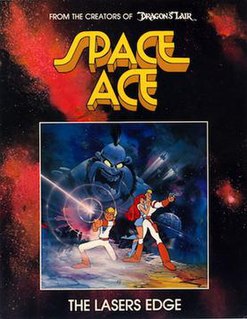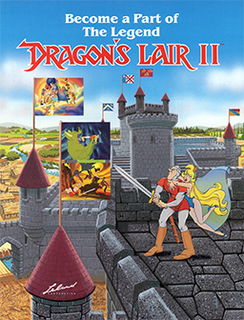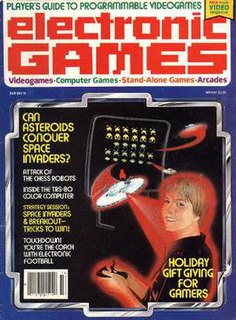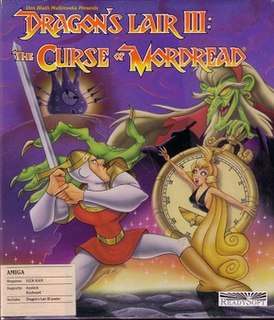Gauntlet or The Gauntlet may refer to:

Technōs Japan Corp. was a Japanese video game developer, best known for the Double Dragon and Kunio-kun franchises. As of June 2015, Arc System Works owns the intellectual properties of Technōs Japan.

Double Dragon is a beat 'em up video game series initially developed by Technōs Japan and released as an arcade game in 1987. The series features twin martial artists, Billy and Jimmy Lee, as they fight against various adversaries and rivals. Due to the popularity of the game series, a 1993 animated series and 1994 live-action film adaptation were produced; these were widely-panned by critics and audiences.
1983 has seen many sequels and prequels in video games and several new titles such as Mario Bros., Pole Position II and Spy Hunter.

Donald Virgil Bluth is an American film director, animator, production designer, video game designer, and animation instructor, best known for his animated films, including The Secret of NIMH (1982), An American Tail (1986), The Land Before Time (1988), All Dogs Go to Heaven (1989), Anastasia (1997), and Titan A.E. (2000), for his involvement in the LaserDisc game Dragon's Lair (1983), and for competing with former employer Walt Disney Productions during the years leading up to the films that became the Disney Renaissance. He is the older brother of illustrator Toby Bluth.

Space Ace is a LaserDisc video game produced by Bluth Group, Cinematronics and Advanced Microcomputer Systems. It was unveiled in October 1983, just four months after the Dragon's Lair game, then released in Spring 1984, and like its predecessor featured film-quality animation played back from a LaserDisc.

Cinematronics Incorporated was an arcade game developer that primarily released vector graphics games in the late 1970s and early 1980s. While other companies released games based on raster displays, early in their history, Cinematronics and Atari, Inc. released vector-display games, which offered a distinctive look and a greater graphic capability, at the cost of being only black and white (initially). Cinematronics also published Dragon's Lair in 1983, the first major LaserDisc video game.

Dragon's Lair II: Time Warp is a 1991 laserdisc video game by the Leland Corporation. It is the first true sequel to Dragon's Lair. As with the original, Dragon's Lair II: Time Warp consists of an animated short film that requires the player to move the joystick or press a fire button at certain times in order to continue. It takes place years after the original Dragon's Lair. Dirk has married Daphne, and the marriage has produced many children. When Daphne is kidnapped by the evil wizard Mordroc in order to be forced into marriage, Dirk's children and his mother-in-law are clearly upset by the abduction of Daphne, and Dirk must once again save her.
An interactive film, also known as movie game, is a video game that presents its gameplay in a cinematic, scripted manner, often through the use of full-motion video of either animated or live-action footage.

Astron Belt (アストロンベルト) is a LaserDisc video game in the form of a third-person, space combat rail shooter released in arcades in 1983 by Sega in Japan, and licensed to Bally Midway for release in the United States. Developed in 1982, it is commonly cited as the first LaserDisc game.
Starcade is a game show where contestants competed against one another by playing arcade video games. The series originally aired on TBS from 1982 to 1983, followed by a run in syndication for the following season.

Electronic Games was the first dedicated video game magazine published in the United States and ran from October 15, 1981 to 1997 under different titles. It was co-founded by Bill Kunkel, Joyce Worley, and Arnie Katz, and is not to be confused with Electronic Gaming Monthly.

Dragon's Lair 3D: Return to the Lair is an action-adventure video game released in 2002 by Dragonstone Software. The game is based on Cinematronics' 1983 laserdisc arcade game Dragon's Lair, and follows a similar story; the hero, Dirk the Daring, must enter the evil wizard Mordroc's castle to rescue Princess Daphne from Singe the Dragon. Many of the characters and locations from the 1983 original make appearances in the game, along with new puzzles, rooms and enemies. Animator and director Don Bluth, who produced the cartoon animation for the arcade original, also produced two new animated sequences for the opening and ending of the game. The game uses cel shading to mimic the distinctive style of the original.

Wonder Boy III: Monster Lair is a side-scrolling action game developed by Westone Bit Entertainment that was originally released for the arcades by Sega in 1988. It is the third game in the Wonder Boy series and the last one released for the arcade. A console adaptation was made by Hudson Soft, released in 1989 in Japan for the PC Engine CD-ROM² System and the subsequent North American release on the TurboGrafx-CD dropped the 'Wonder Boy III' title. It was also converted and released by Sega for the Mega Drive in Japan in 1990 and Europe in 1991. Both, the TurboGrafx-CD and Mega Drive versions have been re-released for the Wii Virtual Console.

Princess Daphne is a fictional character from the Dragon's Lair series of video games. She was created and designed by Rick Dyer and Don Bluth and introduced in the original Dragon's Lair in 1983.

Dragon's Lair is an interactive film LaserDisc video game developed by Advanced Microcomputer Systems and published by Cinematronics in 1983, as the first game in the Dragon's Lair series. In the game, the protagonist Dirk the Daring is a knight attempting to rescue Princess Daphne from the evil dragon Singe who has locked the princess in the foul wizard Mordroc's castle. It featured animation by ex-Disney animator Don Bluth.

Dragon's Lair is a video game franchise created by Rick Dyer and Don Bluth. The series is famous for its Western animation-style graphics and convoluted decades-long history of being ported to many platforms and being remade into television and comic book series.
Rick Dyer is an American video game designer and writer best known for creating Dragon's Lair. He founded RDI Video Systems, the developer of Dragon's Lair, Space Ace, and also Thayer's Quest, which was a conversion kit for Dragon's Lair.

Dragon's Lair III: The Curse of Mordread is a video game in the Dragon's Lair series, developed by Don Bluth Multimedia and published by ReadySoft Incorporated for the Amiga, Atari ST and MS-DOS in 1993.
ReadySoft was a video game developer and publisher and distributor founded in 1987 by David Foster, based in Ontario, Canada. Products include various emulators as well as home computer ports of Sullivan Bluth's videodisc game series Dragon's Lair, Space Ace and their sequels. As a publisher, they frequently handled North American release of games by French developer Silmarils.












